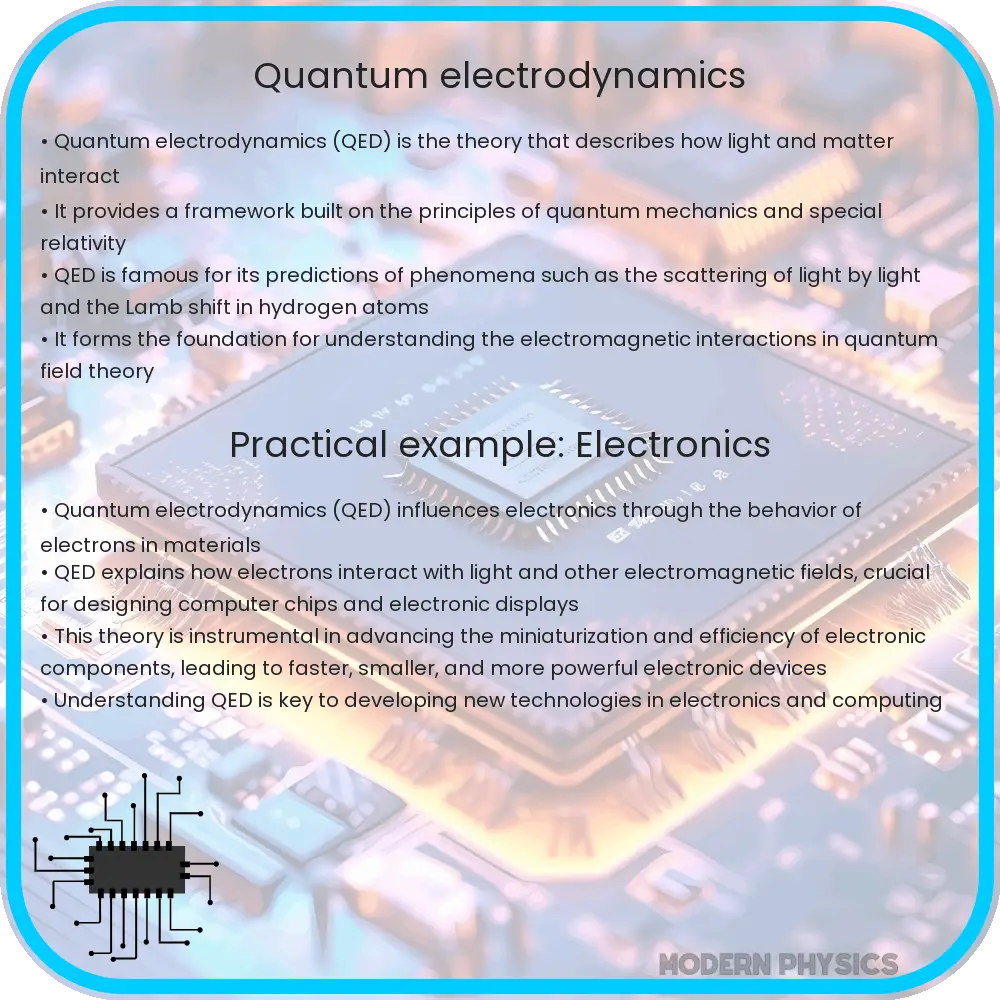Explore Quantum Electrodynamics (QED): Uncover its principles, applications in technology and physics, and impact on modern scientific understanding.

Introduction to Quantum Electrodynamics (QED)
Quantum Electrodynamics (QED) is a cornerstone of modern physics, offering a comprehensive framework for understanding the interactions between light and matter. As a quantum field theory, QED extends classical electromagnetism to account for the quantum properties of particles and fields. This theory has played a pivotal role in advancing our understanding of atomic, molecular, and optical physics, with wide-ranging applications across various scientific disciplines.
Key Principles of QED
At its core, QED is based on the quantization of the electromagnetic field and the introduction of the concept of virtual particles. The fundamental equation of QED, the Dirac equation, describes how charged particles such as electrons and positrons interact with the electromagnetic field. QED employs the language of Feynman diagrams, which are graphical representations that simplify the calculation of interaction probabilities between particles.
One of the remarkable features of QED is its ability to predict physical quantities with extraordinary precision. For instance, QED’s predictions for the anomalous magnetic moment of the electron match experimental measurements to more than ten decimal places, showcasing the theory’s astonishing accuracy.
Applications of QED
QED’s applications are vast and influential in various scientific and technological fields. In atomic physics, QED provides explanations for phenomena such as the Lamb shift, where there is a slight difference in energy levels of hydrogen atoms predicted by Dirac’s theory. In quantum computing, QED principles guide the development of qubits and quantum gates, fundamental components of quantum computers.
Moreover, QED is instrumental in the field of particle physics. It forms a part of the Standard Model, which is the theoretical framework describing the fundamental particles and forces in the universe. Through its combination with the weak nuclear force, QED helps in explaining processes like beta decay in nuclear physics.
Principles Underlying QED
QED is founded on several key principles that define its theoretical structure. First and foremost is the principle of superposition, which states that the state of a system is a superposition of its quantum states. This principle is crucial for explaining interference patterns in light and electrons. Another fundamental principle is the conservation of charge, ensuring that the total electric charge in an isolated system remains constant over time.
Additionally, QED respects the principles of quantum mechanics and special relativity, merging them into a coherent theoretical framework. This union is exemplified in the concept of quantum fields, which are treated as operator-valued fields satisfying quantum mechanical commutation relations and obeying the principles of special relativity.
In conclusion, Quantum Electrodynamics stands as a profound achievement in theoretical physics, offering deep insights into the nature of light and matter interactions. Its principles and applications continue to shape our understanding of the physical world and drive innovations in technology and science.
Further Insights into QED
Delving deeper into the nuances of QED, we encounter the concept of renormalization. This process addresses the infinities that arise in QED calculations, allowing for meaningful physical predictions. Renormalization adjusts the parameters of the theory (like mass and charge) to counteract the infinite contributions from higher-order processes. This technique has been vital in solidifying QED’s status as a physically consistent and predictive theory.
Challenges and Limitations
Despite its successes, QED is not without challenges. The theory becomes increasingly complex at high energies, leading to difficulties in performing accurate calculations. Additionally, QED cannot fully explain gravitational interactions or phenomena requiring a quantum theory of gravity. These limitations have spurred ongoing research in unifying QED with other fundamental forces under a grand theory of everything.
Quantum Electrodynamics in Modern Technology
QED has significantly influenced modern technology. In the field of photonics, QED principles are employed in designing lasers and optical fibers, revolutionizing telecommunications. In medical technology, QED contributes to the development of precise radiation therapies for cancer treatment, enhancing their effectiveness and safety.
Moreover, the semiconductor industry owes much to QED. The theory assists in understanding and manipulating the electronic properties of materials, paving the way for the development of transistors, integrated circuits, and various electronic components.
Concluding Remarks
In conclusion, Quantum Electrodynamics represents a monumental stride in our quest to comprehend the universe’s workings. Its precise predictions and successful integration of quantum mechanics and electromagnetism have made it a fundamental pillar of modern physics. While challenges remain, particularly in integrating it with other forces, its contributions to science and technology are undeniable. As research continues, QED remains a vibrant and essential field, continually enhancing our understanding of the natural world and driving technological innovation.
From atomic scales to cosmic phenomena, QED’s influence pervades, offering a deeper understanding of the universe and inspiring future generations of scientists. Its legacy is a testament to human ingenuity and the relentless pursuit of knowledge, making it a subject of endless fascination and importance in the scientific community.
